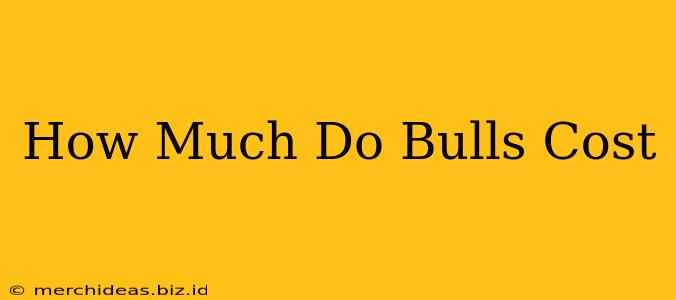Buying a bull is a significant investment for any cattle operation, whether you're a seasoned rancher or just starting out. The price of a bull can vary dramatically depending on several key factors. This guide will break down the costs involved and help you understand what influences the final price tag.
Factors Affecting Bull Prices
Several crucial elements impact how much you'll pay for a bull. Understanding these factors is vital for making an informed decision and securing a bull that's the right fit for your operation.
Breed:
This is perhaps the most significant factor. Popular and highly sought-after breeds, known for their superior genetics in terms of meat quality, milk production, or other desirable traits, tend to command higher prices. For example, a registered Angus bull from a reputable breeder will typically cost more than a crossbred bull of unknown lineage.
Age:
Yearling bulls (12-15 months old) are generally cheaper than mature bulls (24 months or older). However, mature bulls offer the advantage of proven breeding performance and established genetic traits. The choice depends on your needs and budget.
Genetics and Performance:
Bulls with exceptional genetic profiles, backed by performance data (e.g., Expected Progeny Difference or EPD scores), will command a premium. These metrics predict the likely performance of the bull's offspring, offering breeders a valuable tool for improving their herds. Bulls with superior lineage and proven track records in areas like growth rate, carcass quality, and fertility significantly impact cost.
Health and Conformation:
A healthy bull with sound conformation (body structure) is essential. A thorough veterinary examination is crucial before purchasing. Bulls with health issues or structural defects will be cheaper, but the potential risks and veterinary bills could outweigh the initial savings.
Location and Market Conditions:
Geographic location and current market demands influence pricing. Bull prices can fluctuate based on supply and demand, seasonal factors, and overall economic conditions. Regional differences in breeding trends and market preferences also play a role.
Seller Reputation and Breeding Program:
Buying from a reputable breeder with a strong breeding program adds value. Established breeders invest in superior genetics, health testing, and meticulous record-keeping. This translates to higher initial costs but minimizes risks and increases the likelihood of success.
Price Ranges: What to Expect
While providing exact figures is impossible due to the many variables, here's a general idea of bull prices:
-
Lower end: You might find bulls for sale in the range of $2,000-$4,000, but these are typically younger, less proven bulls or those with less desirable genetics.
-
Mid-range: Expect to pay $4,000-$8,000 for a well-bred, healthy bull with good conformation and some performance data.
-
Higher end: High-quality, registered bulls from elite breeding programs can cost $8,000 or more, sometimes reaching tens of thousands of dollars for exceptional genetics and proven performance.
Tips for Buying a Bull
- Do your research: Investigate different breeds and their suitability for your operation.
- Visit several breeders: Compare bulls and their prices.
- Inspect the bull thoroughly: Check for signs of health problems and assess its conformation.
- Request performance data and genetic information: This will help you choose a bull that meets your needs.
- Negotiate the price: Don't be afraid to negotiate, especially if you're buying multiple bulls.
- Get a veterinary examination: Before finalizing the purchase, have a veterinarian examine the bull to ensure its health.
Buying a bull is a significant financial commitment. By carefully considering the factors mentioned above and conducting thorough research, you can make an informed decision that aligns with your budget and improves your herd's genetic potential. Remember to factor in additional costs such as transportation, health testing, and potential veterinary care.
